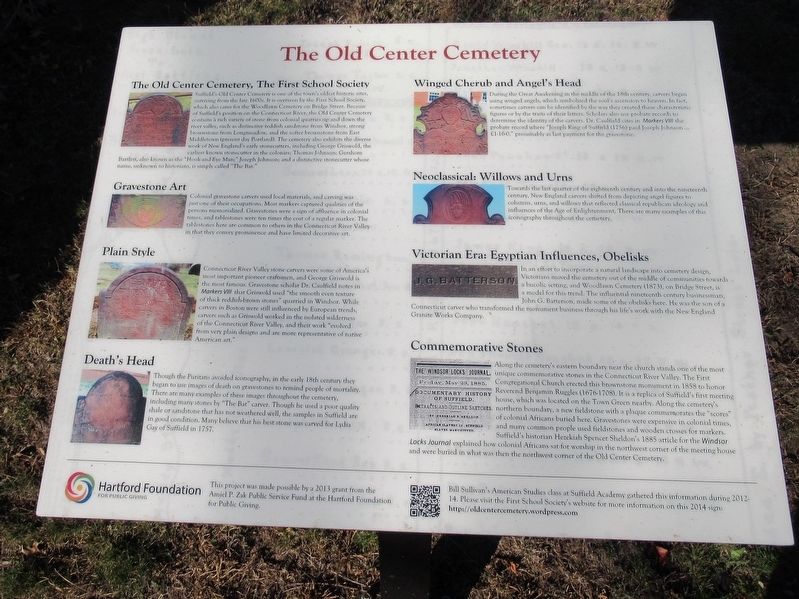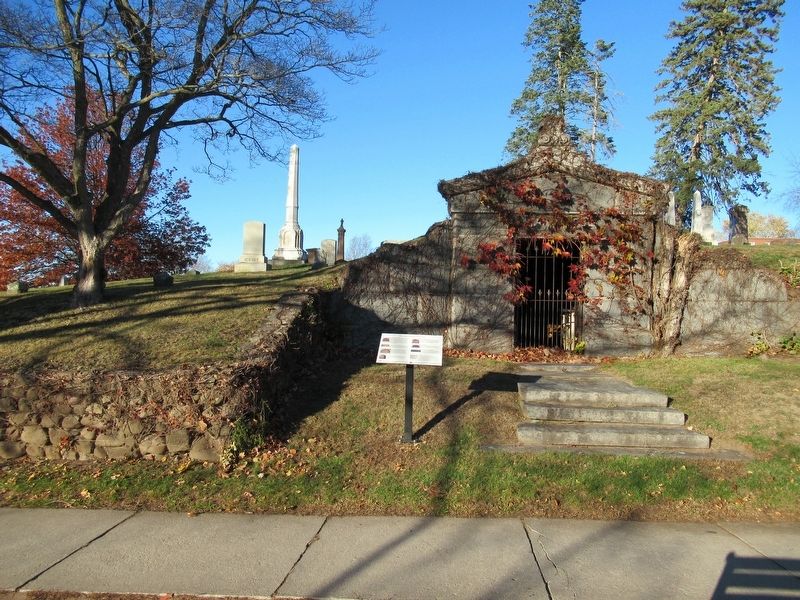Suffield Depot in Hartford County, Connecticut — The American Northeast (New England)
The Old Center Cemetery
— Suffield, Connecticut —
The Old Center Cemetery, The First School Society
Suffield's Old Center Cemetery is one of the town's oldest historic sites, surviving from the late 1600s. It is overseen by the First School Society, which also cares for the Woodlawn Cemetery on Bridge Street. Because of Suffield's position on the Connecticut River, the Old Center Cemetery contains a rich variety of stone from colonial quarries up and down the river valley, such as distinctive reddish sandstone from Windsor, strong brownstone from Longmeadow, and the softer brownstone from East Middletown (present day Portland). The cemetery also exhibits the diverse work of New England's early stonecutters, including George Griswold, the earliest known stonecutter in the colonies, Thomas Johnson; Gershom Bartlett, also known as the "Hook-and-Eye Man; “Joseph Johnson; and a distinctive stonecutter whose name, unknown to historians, is simply called "The Bat."
Gravestone Art
Colonial gravestone carvers used local materials, and carving was just one of their occupations. Most markers captured qualities of the persons memorialized. Gravestones were a sign of affluence in colonial times, and tablestones were ten times the cost of a regular marker. The tablestones here are common to others in the Connecticut River Valley in that they convey prominence and have limited decorative art.
Plain Style
Connecticut River Valley stone carvers were some of America's most important pioneer craftsmen, and George Griswold is the most famous. Gravestone scholar Dr. Caulfield notes in Markers VIII that Griswold used "the smooth even texture of thick reddish-brown stones" quarried in Windsor. While carvers in Boston were still influenced by European trends, carvers such as Griswold worked in the isolated wilderness of the Connecticut River Valley, and their work "evolved from very plain designs and are more representative of native American art."
Death's Head
Though the Puritans avoided iconography, in the early 18th century they began to use images of death on gravestones to remind people of mortality. There are many examples of these images throughout the cemetery, including many stones by "The Bat" carver. Though he used a poor quality shale or sandstone that has not weathered well, the samples in Suffield are in good condition. Many believe that his best stone was carved for Lydia Gay of Suffield in 1757.
Winged Cherub and Angel's Head
During the Great Awakening in the middle of the 18th century, carvers began using winged angels, which symbolized the soul's ascension to heaven. In fact, sometimes carvers can be identified by the way they created these characteristic figures or by the traits their letters. Scholars also use probate records to of determine the identity of the carvers. Dr. Caulfield cites in Markers VIII the probate record where "Joseph King of Suffield (1756) paid Joseph Johnson £1-16-0," presumably as last payment for the gravestone.
Neoclassical: Willows and Urns
Towards the last quarter of the eighteenth century and into the nineteenth century, New England carvers shifted from depicting angel figures to columns, urns, and willows that reflected classical republican ideology and influences of the Age of Enlightenment. There are many examples of this iconography throughout the cemetery.
Victorian Era: Egyptian Influences, Obelisks
In an effort to incorporate a natural landscape into cemetery design, Victorians moved the cemetery out of the middle of communities towards a bucolic setting, and Woodlawn Cemetery (1873), on Bridge Street is a model for this trend. The influential nineteenth century businessman, John G. Batterson, made some of the obelisks here. He was the son of a Connecticut carver who transformed the monument business through his life's work with New England Granite Works Company.
Commemorative Stones
Along the cemetery's eastern boundary near the church stands one of the most unique commemorative stones in the Connecticut River Valley. The First Congregational Church erected this brownstone monument in 1858 to honor Reverend Benjamin Ruggles (1676-1708). It is a replica of Suffield's first meeting house, which was located on the Town Green nearby. Along the cemetery's northern boundary, a new fieldstone with a plaque commemorates the "scores” of colonial Africans buried here. Gravestones were expensive in colonial times and many common people used fieldstones and wooden crosses for markers. Suffield's historian Hezekiah Spencer Sheldon's 1885 article for the Windsor Locks Journal explained how colonial Africans sat for worship in the northwest corner of the meeting house and were buried in what was then the northwest corner of the Old Center Cemetery.
This project was made possible by a 2013 grant from the Amiel P. Zak Public service Fund at the Hartford Foundation for Public Giving.
Bill Sullivan’s American Studies class at Suffield Academy gathered this information during 2012-14. Please visit the First School Society’s website for more information on this 2014 sign: http://old.cemetery.wordpress.com
Topics. This historical marker is listed in this topic list: Cemeteries & Burial Sites.
Location. 41° 58.965′ N, 72° 39.175′ W. Marker is in Suffield, Connecticut, in Hartford County. It is in Suffield Depot. Marker is at the intersection of Mountain Road (Connecticut Route 168) and High Street, on the right when traveling west on Mountain Road. Touch for map. Marker is in this post office area: Suffield CT 06078, United States of America. Touch for directions.
Other nearby markers. At least 8 other markers are within 4 miles of this marker, measured as the crow flies. Suffield Soldiers Memorial (about 500 feet away, measured in a direct line); Suffield (about 600 feet away); Suffield Veterans Monument (about 700 feet away); Enfield Soldiers Monument (approx. 2.9 miles away); Connecticut Fallen Firefighters’ Memorial (approx. 3 miles away); Founders of Enfield (approx. 3.1 miles away); First Church in Enfield (approx. 3.1 miles away); Old Town Hall of Enfield (approx. 3.1 miles away). Touch for a list and map of all markers in Suffield.
Credits. This page was last revised on February 10, 2023. It was originally submitted on November 19, 2016, by Michael Herrick of Southbury, Connecticut. This page has been viewed 502 times since then and 50 times this year. Photos: 1, 2. submitted on November 19, 2016, by Michael Herrick of Southbury, Connecticut.

